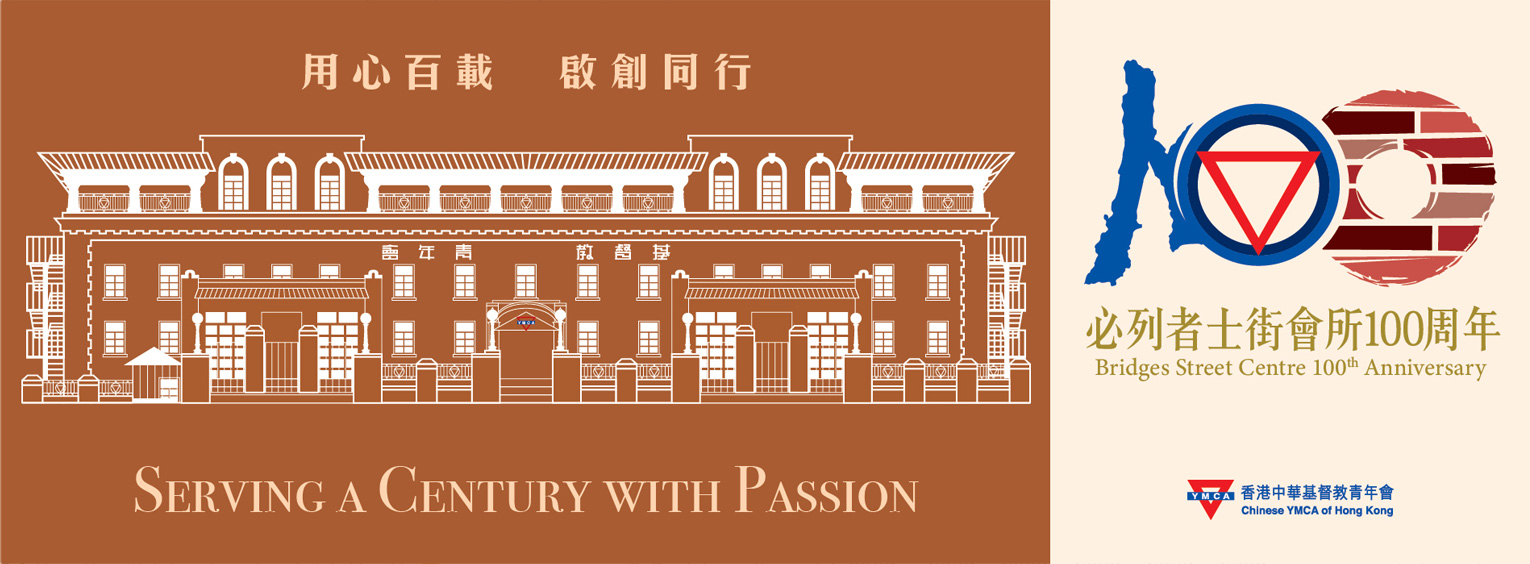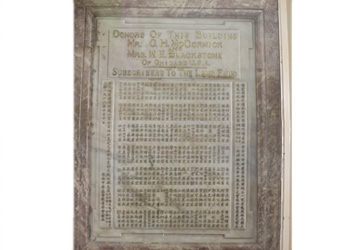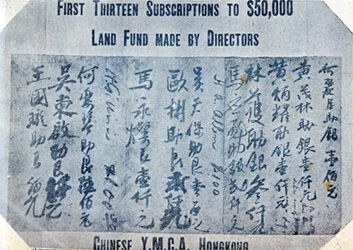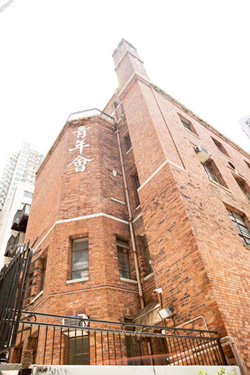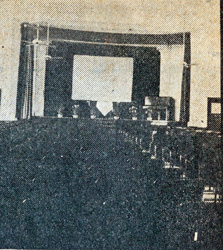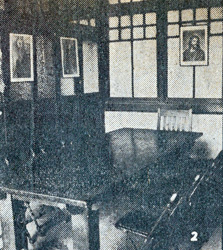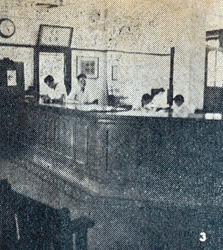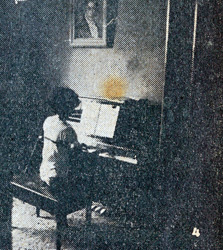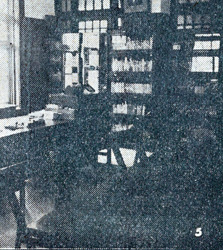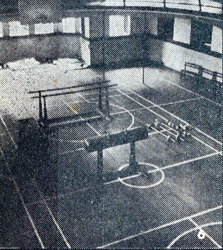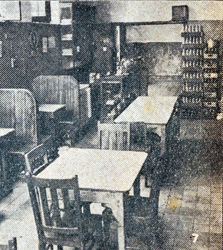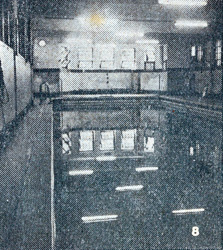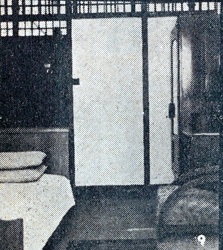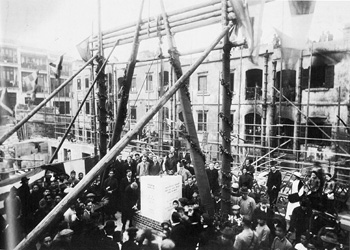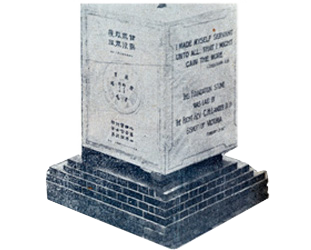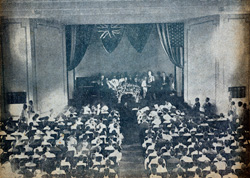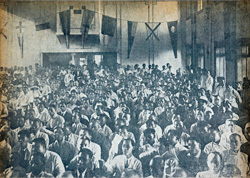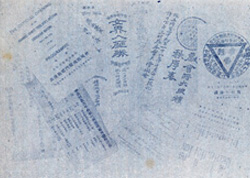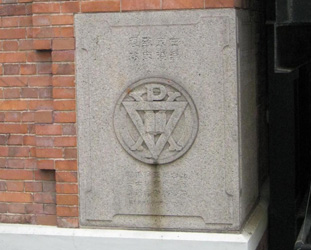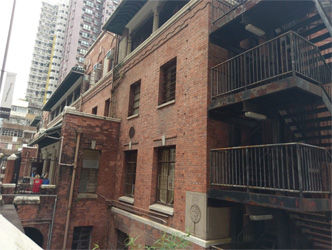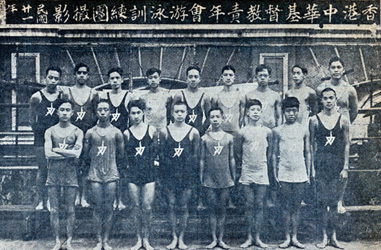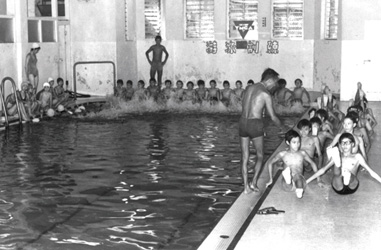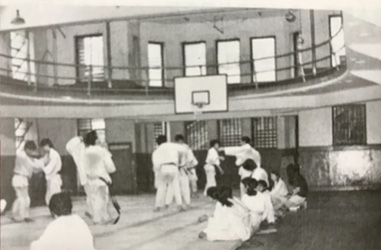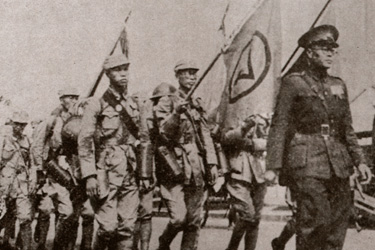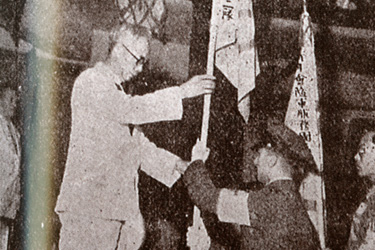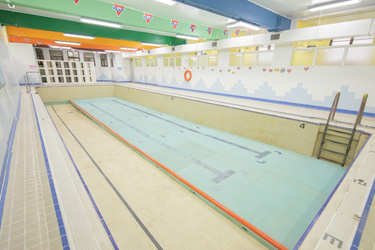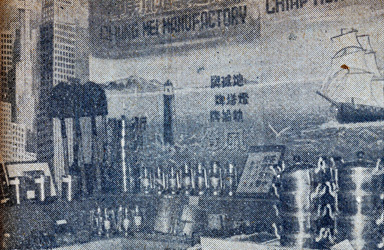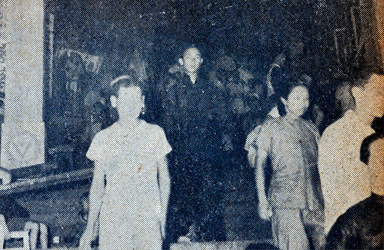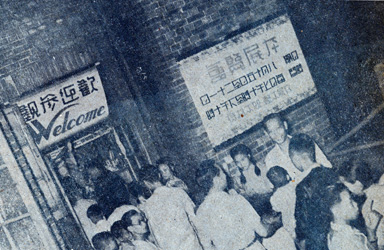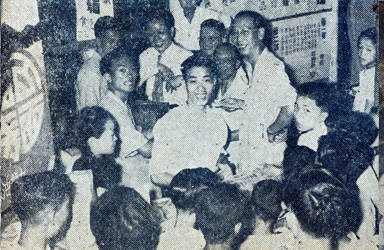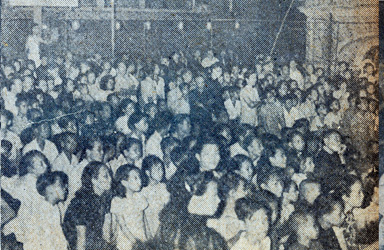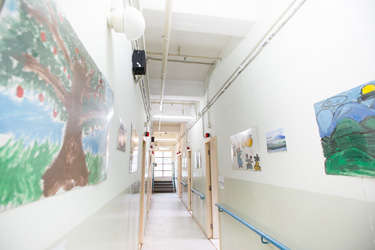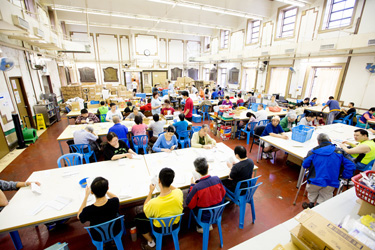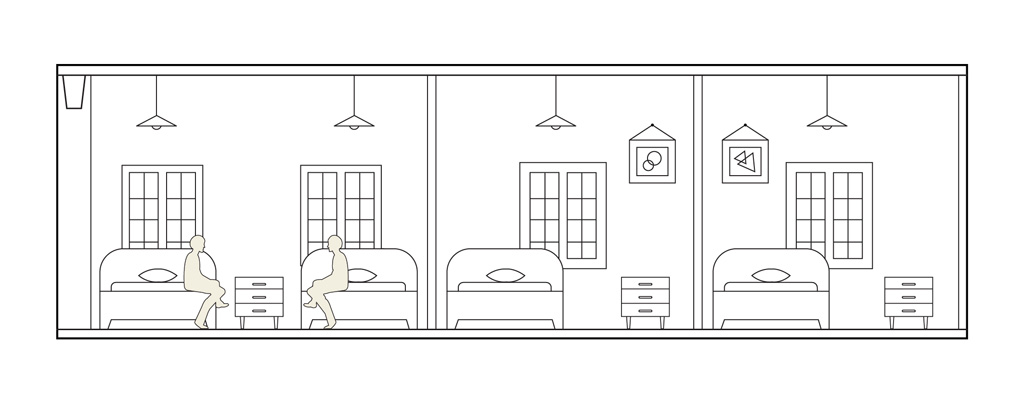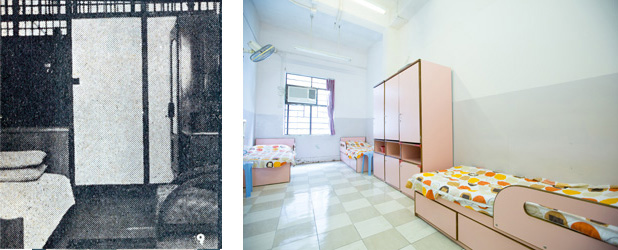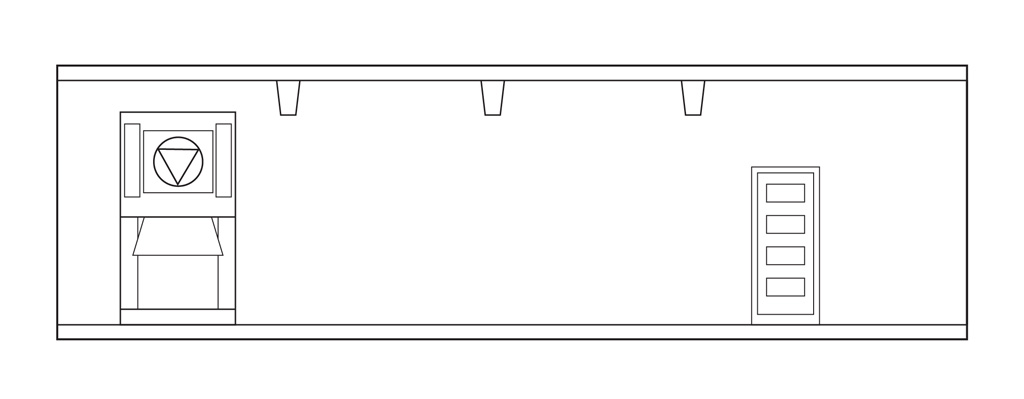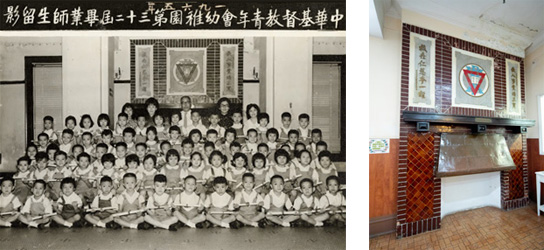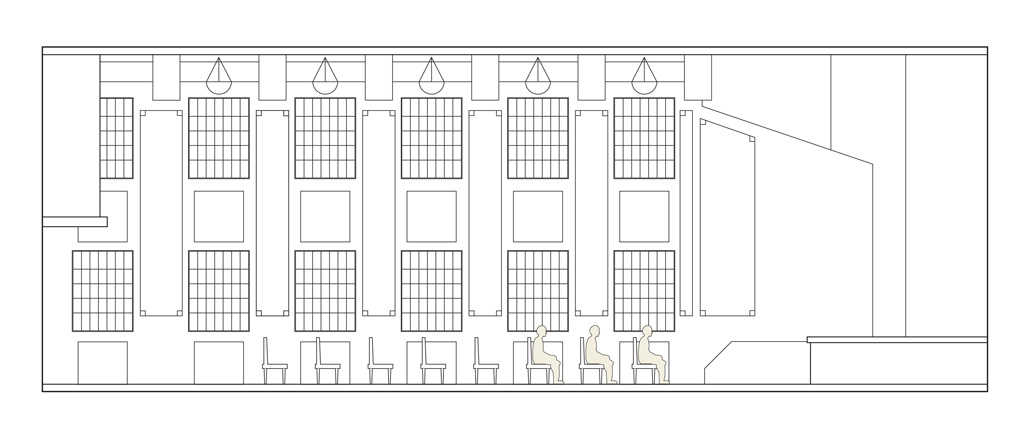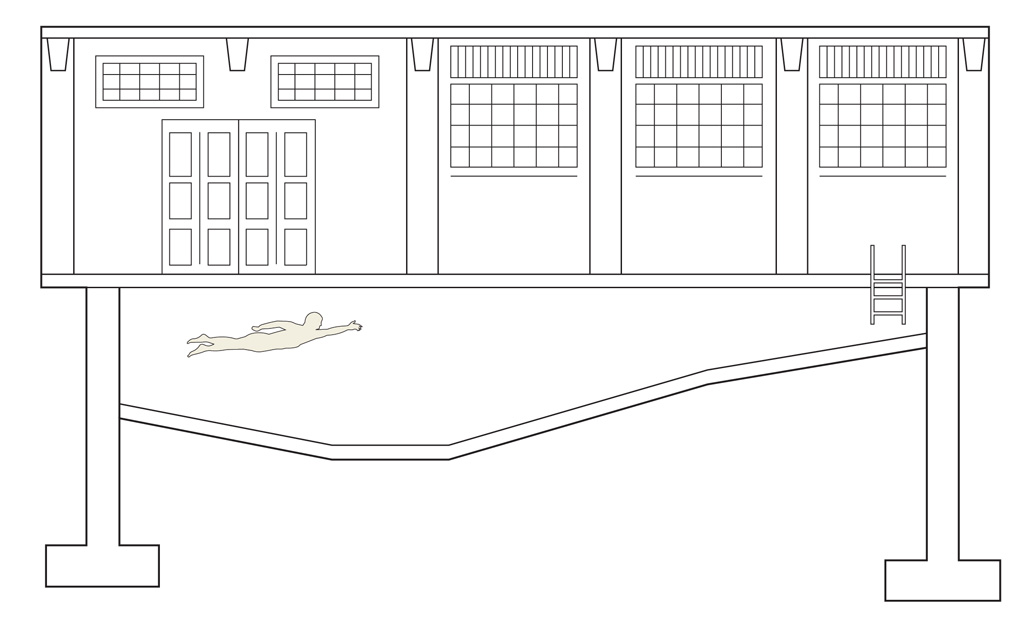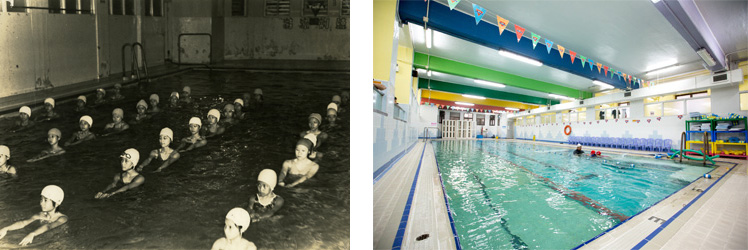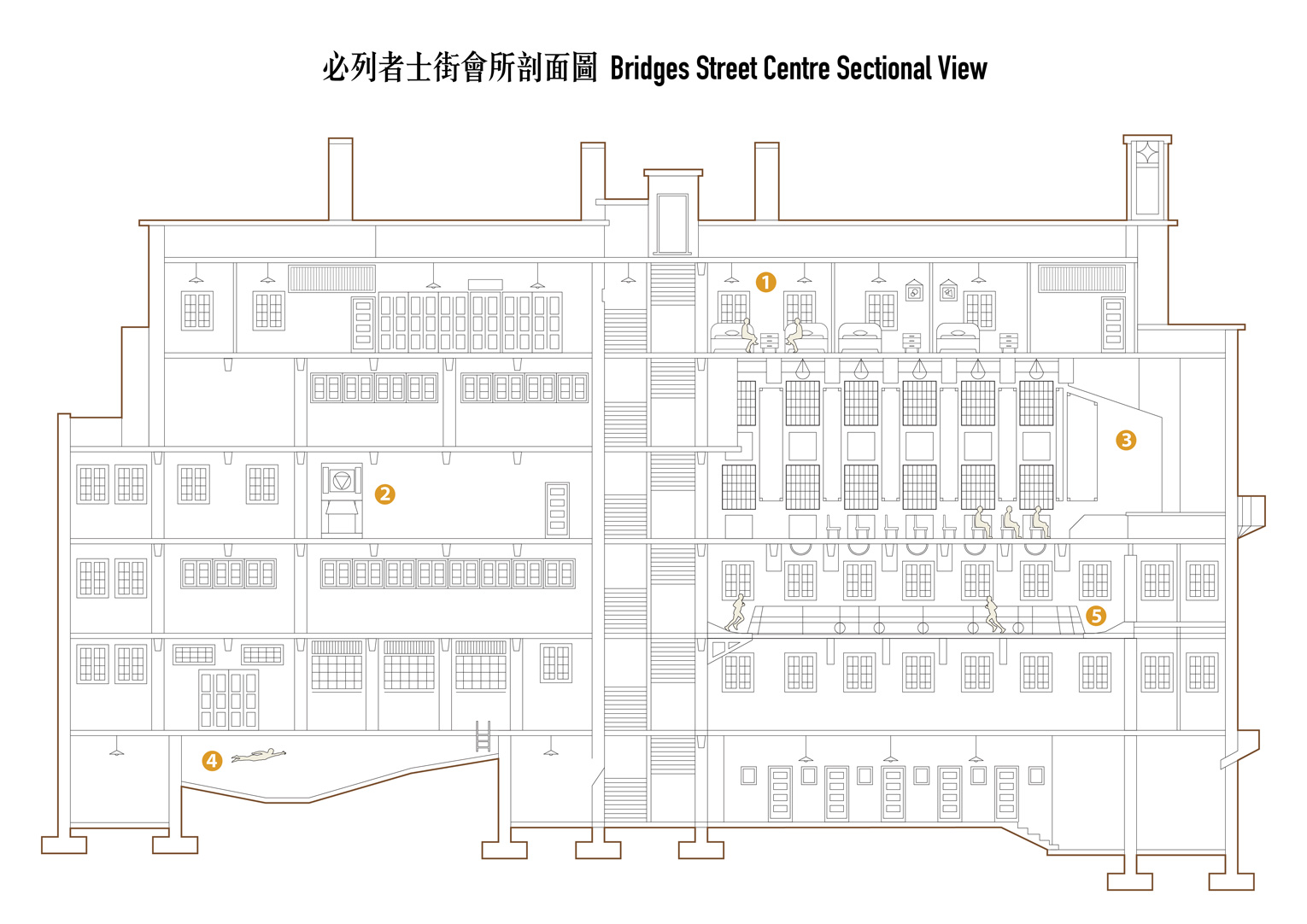- Introduction / Celebrations
- Building / floor features
- History
- Interesting stories of BSC
- Your Joining
- Video and Animation
The Bridges Street Centre
Chinese YMCA of Hong Kong

Chinese YMCA of Hong Kong’s Bridges Street Centre is located in Sheung Wan on the western side of Hong Kong Island. Built in 1918 through the generous support of prominent members and community business leaders, the Centre was originally named “The Central Building” and served as the headquarters of the Association before 1966.
This six-floor building was constructed with a symmetrical design using red bricks and concrete as the major building materials and built in a style that emphasised simplicity. The building integrated Chinese and Western design elements and was well-equipped with advanced facilities for the time, including Hong Kong’s first indoor swimming pool to have both a cool and warm water supply and the first elevated wok-shaped running track in Hong Kong.
The Centre quickly became the main gathering place for local people during the early part of the 20th century. The famous Chinese writer Lu Xun lectured at the Centre in 1927 and the first-ever group wedding ceremony took place here in 1936. During the Battle of Hong Kong in 1941, the building was used for Hong Kong’s Air Raid Precaution Department and to accommodate refugees. In 2009, the Centre was declared a Grade 1 Historic Building and now provides rehabilitation services for the mentally disabled as well as a number of sports and recreation services
The Bridges Street Centre 100th Anniversary Celebration
115th anniversary Kick-off Ceremony
Date: 20 March 2016 (Sun)
Time: 10:00 a.m.-10:30a.m.
Venue: Tung Fong Street, Yau Ma Tei
Officiating guests:
Ms. Florence Hui Hiu-fai, SBS, JP, Under Secretary for Home Affairs
Mr. Lau Ming-wai, BBS, JP, Chairman of Commission on Youth
Prof. Roland Chin Tai-hong, BBS, JP, President of Hong Kong Baptist University
Ms. Wong Wan-Yiu, former Hong Kong cycling team member
Dr. Frank Cheng, President of Chinese YMCA of Hong Kong
Mr. Yau Chung-wan, Vice-president of Chinese YMCA of Hong Kong
Mr. Karl Lau, General Secretary of Chinese YMCA of Hong Kong
115th Anniversary Celebration Parade
Date: 20 March 2016 (Sun)
Time: 10:30 a.m.-12:30p.m.
Kick-off Ceremony: The Kick-off ceremony will be commenced at Tung Fong Street, right beside the head office of Chinese YMCA of Hong Kong at Waterloo Road.
No. of Participants: 1,550 people
The parade team: The parade, led by open top bus, mini cars and bicycles, will be started by uniform groups, school and educational teams, different groups, members and centres’ performance teams.
Parade route: Tung Fong Street—Nathan Road—Jodan Road—Canton Road—Tsim Sha Tsui Clock Tower
History of the Bridges Street Centre
The Founding of the Bridges Street Centre
Chinese YMCA of Hong Kong was founded in 1901. The Association’s first headquarters was a residential building on Des Voeux Road, Central. The initial goal of the Association was to improve the quality of life for everyone in Hong Kong by fulfilling a number of urgent educational and recreational needs. With the rapid growth in the numbers of both members and staff, in 1910 the Association decided to build a dedicated centre. Given the fact that Sheung Wan district was one of Hong Kong’s most prosperous places at the time, plus the fact that a YMCA student dormitory was already located on Bridges Street, the Association decided that this street was an ideal location for such a centre.
The construction of the Bridges Street Centre was funded by the YMCA of North America and supported by prominent members and business leaders in Hong Kong. In 1912, YMCA representatives participating in a youth meeting held at the White House in Washington D.C. remarked that Chinese YMCA of Hong Kong had no self-financed property. The group proposed offering a subsidy of USD 75,000 to Chinese YMCA of Hong Kong, on the condition that they must then raise a sum of USD 25,000 within five years.
After receiving the good news, the Association proceeded to organise fundraising efforts, inviting donations from all directors, honorary directors, local Chinese businessmen and existing members. Significant donations were made by Mr Ma Ying Piu, the founder of Sincere Department Store; Mr Kwok Lok, the co-founder of Wing On Department Store; Mr Wu Ting Fang, the first Chinese member of the Legislative Council of Hong Kong; Sir Kai Ho, the first Chinese person to receive a British knighthood; Dr Li Shu Fan and numerous others. The Sun, one of the top four Chinese-funded consortiums, and several foreign-funded enterprises such as the former Sassoon Group and Mitsui and Co. also made substantial donations.
According to the YMCA archives, Mr Huang Mou-lin, the president of Chinese YMCA of Hong Kong at the time, pledged to donate one thousand dollars (one-fifth of his assets) to support the building project. In response to the fundraising call, further donors stepped forward, like property tycoon Mr Lam Woo, who donated $3,000; and Mr Ma Ying Piu and Mr Au Ban, who each donate $2,000 respectively. Through the generous support of these prominent members, the Association raised a total of USD 25,000. In another positive development, the Association then successfully negotiated with the government to reduce the purchase price of the lot on Bridges Street to USD 25,000.
The construction of the six-storey building, covering an area of 10,800 square feet, commenced in 1915. Designed by American architects Shattuck and Hussey, the construction was executed by a local developer, Mr A.R.E. Rewen. The building was designed in a classic colonial revival style, with red bricks and concrete as the predominant building materials, since reinforced concrete was in wide use at the time. These elements have since become iconic features of the Centre.
The building is a large and rectangular with a flat tiled roof and a symmetrical façade. Chinese features like green glazed tiles and memorial archways are found throughout the structure. Upon completion, the six-storey building was equipped with a wide range of features and facilities, including an assembly hall, a social room, a café, a small lecture hall, a fitness room, a dormitory, a kitchen and a dining hall, a library, a swimming pool, changing rooms, a Chinese language day school and a commerce-related evening school.
The foundation stone for the Centre was laid by the Bishop of Victoria, the Right Rev. C.H. Lander D.D., on 10 February 1917. After two years and eight months of construction and fit out, the Central building was completed and was officially opened by the Hon. Claud Severn, C.M.G. on 10 October 1918. Immediately afterwards, the Association held a five-day celebration, with celebratory speeches, gymnastics performances, concerts, a lantern carnival and several open days. In total more than 23,000 people visited the Centre over the five days.
Two maxims are engraved in Chinese on the cornerstone of the building: “Willing to serve the public” and “One salvation for all peoples”. These are displayed above and below the ring-shaped emblem on the stone, representing the integrity and the unity of life. The inner ring represents the Association’s oath and our members’ friendship and love for the world, while the XP, the earliest form of the Christogram, is an abbreviation of the Greek Chi Rho, meaning “Christ”. The outer part of the red triangle emblem represents the Trinity, while the inner portion represents the human spirit, mind and body.
Modern Facilities
When it was unveiled, the Central Building was home to the first-ever Chinese-style hall for local Hongkongers, along with several new recreational facilities like an indoor swimming pool and the first elevated wok-shaped running track in Hong Kong. At the time, these facilities were considered modern and cutting edge, and helped promote a society-wide campaign to boost people’s health known as “survival of the fittest”. In the first 70 days after the Centre was opened – between 23 October 1918 and 3 January 1919 – a total of 1,557 fitness room users, 730 swimming room users and 1,557 shower room users were recorded, an indication of how well the Centre was received by the public. After the opening, the number of Association members grew to 2,068 and 10,419 people participated in various post-opening events.
In the early 20th century, there was a dearth of large assembly halls in Hong Kong where large-scale speeches, gatherings or art exhibitions could be held. Since the Central Building was both large and well-equipped, many important activities of the day were held on the premises.
Two of the most famous events that took place here were the lectures delivered by notable Chinese writer Lu Xun, who was invited by the Association and the University of Hong Kong to speak on the topics of a “voiceless China” and how “the old way of writing and speaking is coming to an end” on 18 and 19 February 1927. His speeches promoted the written Chinese language and literary reform. According to records, the events attracted a full house with over 600 people in the audience. Today, these lectures are hailed as the starting point of language reform in Hong Kong as well as a significant event in the history of Chinese literature.
The first-ever collective wedding ceremony in Hong Kong also took place in the building’s assembly hall on 15 February 1936. To steer society away from the existing custom of extravagant and wasteful weddings and promote a new concept – the “frugal wedding” – this group wedding as held at the Central Building. Celebrities of the day were invited to share tips on how to maintain a healthy marriage and a good relationship with their in-laws, while information on birth control was also given out. Mr Au Wai Kok, President of the Shanghai Commercial Bank along with the President of Chinese YMCA of Hong Kong chaired the event; while Sir Shouson Chow, the first Chinese member of the Executive Council, acted as a witness for the 11 couples. The ceremony itself was conducted in front of over 500 spectators. And also, a conference organised by the Anti-Slavery Society was held in the Central Building on 26 March 1922.
Since the Association actively promotes youth services – both in the early years and today – sports facilities were a crucial feature of the Central Building. At the beginning of 20th century, physical fitness was not a high priority for local people in Hong Kong. To change this prevailing mind-set and promote “physical education to make Chinese people more fit”, the designers and architect made sure to equipt the Central Building with numerous sports facilities like a basketball court, Hong Kong’s first indoor swimming pool and an elevated wok-shaped running track.
The building’s indoor swimming pool is heated in the winter and was used as a venue for swimming classes from the outset. In 1930, the Association founded its first swimming team; subsequently, we joined the Sports Federation and the Olympic Committee of Hong Kong and became a founding member of the Hong Kong Amateur Swimming Association.
The basketball court included an elevated wok-shaped wooden running track, with fitness equipment for members located in each of the four corners. The overhead indoor running track was designed by American architects who got their inspiration from all-weather jogging tracks used in winter weather conditions in the U.S and Europe. The wok-shaped design is similar to the cycling tracks in modern velodromes – the tracks’ bowl shape helps maximise the speed of athletes.
Emergency Disaster Relief
Hong Kong’s first classes in First Aid were offered by the Association beginning in 1908. While these initial classes were led by a foreign medical practitioner; we later joined hands with St. John's Rescue Team to form the “Hong Kong St. John Ambulance Brigade Hong Kong Youth Rescue Division”, also known as the Youth Rescue Division. Over the years, the Youth Rescue Division spared no effort to serve the community; during the Shanghai incident of 1932 and the Japanese Invasion of 1941 in particular, the Division shouldered heavy responsibilities. Youth members were even deployed to defend certain positions during battles which occurred during the invasion. The Central Building also served as the headquarters of the Air Raid Precaution (ARP) Department during the Second World War, with the swimming pool even being drained at one point to provide a resting place for ARP volunteers and refugees from aerial bombing. Thousands of residents of Central and Sheung Wan stayed here and received assistance from the staff members during this time.
During the Second World War, we also joined hands with six major Christian groups in Hong Kong to organise refugee relief teams which provided clothing for refugees and others in need. Later, the YMCA War Service Team was set up to provide medical services to wounded soldiers on the frontline; the Team also set up a support station to promote greater military-civilian cooperation.
One of the Team’s members, Mr Lai Cho Tin (1921-1994), the father of renowned Hong Kong composer Mr Lai Siu Tin, joined the “Tsing Ping Society” established by the Association after he settled in Hong Kong as a teenager. During the Japanese Invasion, Mr Lai Cho Tin served as the Tsing Ping Society Choir’s conductor and taught young people how to resist the Japanese occupation through music. In March 1939, the Association held a large-scale performance at Blake Garden in Sheung Wan, with Mr Lai Cho Tin acting as the event’s conductor. After high school, he joined a YMCA military service group set up to motivate the British Army on the front lines while promoting an anti-Japanese campaign behind the front.
During the War, the Association continued to develop and offered different types of support to local people. On 24 February 1938, the Association, the HKYWCA and The Chinese Manufacturers' Association of Hong Kong jointly organised the first domestic product exhibition, which later became the renown Hong Kong Brands and Products Expo. During the Japanese Occupation, which ran from 1941 to 1945, the Central Building was under the control of the Japanese government. Courses in Japanese and German were taught here and all other activities were suspended. During this time, the Association focused only on the provision of medical services.
After the Japanese surrender in 1945, the Central Building resumed its ministry services; in 1948, the building hosted a seven-day event called the Export Products Expo Fair; over 60 booths were set up in the building’s assembly hall and fitness room.
Post-war Development of Services
Hong Kong society changed rapidly in the 1950s and 1960s. To cope with the urgent and evolving needs of the community, the Association raised funds for four major construction projects in the early 1960s: a community centre, the Chinese YMCA Secondary School, our Waterloo Road premises and a sports stadium. Upon completion of the Yau Ma Tei Centre in 1966, the Association officially moved its headquarters to No. 23 Waterloo Road and the Central Building was renamed the Bridges Street Centre.
While no longer the main headquarters of the Association, the Bridges Street Centre continued to play an important role for residents of Central and Sheung Wan throughout the 1960s and beyond. The staff of the Centre mainly focused on working with street children and teenagers, and providing kindergarten education services.
Since the Bridges Street Centre was also known as “the cradle of Hong Kong sports and swimming”, many of the territory’s elite athletes spent time here. In 1954, 12 members of the Association’s swimming team were selected to represent Hong Kong in the Far East Olympic Games. In 1964, two members of our swim team were selected to participate in the Olympic Games in Japan. In 1967, our swimming team won both the men's and women's championships in the Hong Kong Winter Swimming Competition, and all prizes in the women’s group in the famous Cross-Harbour Swim. The Chinese YMCA swim team was also crowned champions in both the men’s and women’s group at the Hong Kong Open Swimming and the Hong Kong Chinese Amateur Swimming competitions.
Over the years, there have been a number of restoration projects carried out on both the interior and the exterior of the Bridges Street Centre. In 1985, the government of British Hong Kong announced that it would withdraw funding for the Bridges Street Centre, triggering a potential crisis. This was exacerbated in the same year when the government’s Works Bureau insisted that the Centre be demolished as the annual maintenance costs were too high. However, the Urban Council’s Cultural Relics Protection Unit felt that the Centre should be preserved and listed as a cultural relic. The Centre was accorded Grade II and Grade I status by the Antiquities Advisory Board in 1981 and 2009 respectively.
The government then changed course and decided to transform the Centre into a sheltered workshop and hostel for the mentally handicapped, with part of the building still used for recreation services. This plan was executed with the assistance of Mrs Lam Chun Sheung, the Deputy Director of the Social Welfare Department; Mr Ko Hon Chiu, the Chairman of the Central and Western District Council; and Mr Wu Chor Nam, the Chairman of the Central and Western District Committee. Under the agreement, the Central Building was preserved and, after approval from the Social Welfare Department, rehabilitation services for the mentally disabled were added to the list of services available at the Bridges Street Centre.
In 1993, the Association received a grant of HKD 10 million from the Social Welfare Department to establish our “Home of Love Hostel” and “Home of Love Sheltered Workshop” on the ground and second floors of the Centre. The hostel and workshop provide employment opportunities, rehabilitation services, counselling, recreation and accommodation for the mentally disabled.
The original assembly hall and sports stadium were converted into sheltered workshops which can accommodate 170 people; on the second floor lie 50 bed spaces for moderately mentally disabled people. The café on the ground floor near the fireplace is currently used to provide on-the-spot work environment training for shelter workers, while serving snacks and beverages to members and the public.
For over a century, from its beginnings as the Central Building to today’s Bridges Street Centre, the Association has provided a wide range of sports, education, counselling and physiotherapy services to the people of Central and Sheung Wan. In the future, the Bridges Street Centre will continue to adhere to the Association’s service objective of “to serve, not to be served” – providing a diversified and high-quality set of services to the community and continuing to move forward with the people of Hong Kong.
Video of BSC History

115th Anniversary Symposium
New Trends and Patterns on Volunteerism
Date:
14 October 2016 (Fri)
Time:
9:00 a.m.-12:30p.m.
Venue:
Chinese YMCA of Hong Kong Kowloon Centre - Multi-purpose Gymnasium
(6/F, Activity Building, 23 Waterloo Road, Yau Ma Tei, Kowloon)
Guest Speakers:
Ms. Florence Hui Hiu-fai, SBS, JP, Under Secretary for Home Affairs
Prof. Lui, Tai-lok, Vice President (Research and Development) of The Education University of Hong Kong
Ms. Sonya Fock, Founder of i-Action
Mr. Peter Chan, Chairperson of Youth Participation and Leadership Development (YPLD) Committee of Asia & Pacific Alliance of YMCAs
Target:
Social Service Sector, Education Sector and Tertiary Students
Fee:
FREE (First-Come, First-Served)
Enquiry:
2783 3379 / [email protected]
Online Enrollment
Deadline for Enrollment:
25 September 2016 (Sun)
Coming soon
Only available in Chinese
Only available in Chinese
必列者士街會所100周年
必列啫士街的人文風景

作者:青年會中學校友陳天權先生
必列啫士街(現稱必列者士街)是上環一條介乎城皇街與水池巷之間的街道,以署理律政司必列啫士(William Thomas Bridges)為名。街道不長,現擁有兩座歷史建築,最古老的一座是香港中華基督教青年會會所,為昔日華人主要的文化康樂活動場所。會所建於此區,反映了這是早年華人聚居的地方。
青年會會所和學校
會所於1918年落成,樓高六層。它並非由華人建立,而是基督教青年會北美協會策劃。從會所大禮堂門口的捐款碑可見,建造費75,000美元由芝加哥的麥金覓先生(Mr. C. H. McCormick)和碧士東夫人(Mrs. W. E. Blackstone)捐出,另有182名本地居民和機構捐款購地,當中不少是赫赫有名的殷商士紳和洋行公司。他們的慷慨解囊令青年會迅速發展,在華人社區紮穩根基。另外會所大樓也不是華人設計,而是出自芝加哥建築師樓Shattuck and Hussey的手筆。紅磚綠瓦,走火鋼梯置於建築物外部,具中西合璧的建築風格。大樓擁有多個香港之最,包括第一間華人會堂,設有第一座室內游泳池及第一條懸空鑊形跑道,並有室內運動場、餐廳和宿舍等,一應俱全。
會所禮堂曾是舉辦文化活動的熱門場所,1922年在此舉行反對蓄婢會成立大會,1923年舉行節儉運動會,1925年舉行青年會美術展覽會。最矚目的是1927年中國近代作家魯迅應邀來港,在此舉行了兩場演講,講題是〈無聲的中國〉和〈老調子已經唱完〉,對新文化運動起了很大的推動作用。1936年香港第一次集體婚禮亦在此舉辦,目的是提倡節儉婚嫁。
香港中華基督教青年會於1908年在德輔道中開辦漢文學校,是最早面向民眾的中文學校之一。1913年租用樓梯街公理堂樓下作為校舍,1918年遷入必列啫士街51號的會所,翌年轉至會所對面的青年會學生宿舍(必列啫士街70號)上課,更名「青年會日校」,1931年成為六年制小學。
戰時學校停課,1946年開辦初中,讓小學畢業生可以繼續升學。1960年青年會董事會決定重建校舍,發展為完全中學,以應付學位不足問題。同年年底拆卸必列啫士街70號的舊校舍,連同政府撥出毗鄰空地,1961年建成八層高的新校舍,定名為「中華基督教青年會中學」。
1966年中華基督教青年會將總部遷往九龍,原有的會所改稱必列者士街會所,繼續用作青少年活動中心。外觀結構未有隨歲月而改變,外牆仍見「基督教青年會」六個中文字,展示20世紀初流行的美術字體。只是禮堂在1995年改為「必愛之家」庇護工場,外人不能隨意入內。2000年青年會中學亦搬家,分階段遷入天水圍。舊校舍於2004年關閉,其後給予國際學校Island Christian Academy使用。
中華基督教會公理堂
必列啫士街另一座地標就是公理堂。美國公理會的喜嘉理牧師(Charles Robert Hager)於1883年來港,得溫清溪、宋梓榮等人相助,在必列啫士街2號租地設立佈道所和書館。同年冬天,孫中山來港就讀聖公會拔萃書室,在公理會領洗。其後他入讀中央書院,住在佈道所三樓宿舍。1901年公理會遷往必列啫士街與樓梯街交界,1912年易名「中華公理會」,1919年加入中華基督教會。1951年公理堂在銅鑼灣禮頓道興建新堂,舊址供廣州遷來的美華中學使用,至1960年代結束。1970年拆卸舊址重建新堂,門牌為必列啫士街68號。
戰後政府在必列啫士街2號公理會佈道所舊址興建室內街市,樓高兩層,1953年落成,設計屬當時流行的包浩斯風格。地下設有26個檔位,售賣魚類及家禽。一樓有33個檔位,售賣牛肉、豬肉、水果及蔬菜。一樓部分空間於1969年闢作室內遊樂場,並加建兩條橋接駁後方的永利街。
電影《歲月神偷》曾在永利街取景,2010年公映後引起大眾關注該區的舊建築。最後市建局放棄重建永利街,必列啫士街街市亦於2011年納入活化歷史建築伙伴計劃,供非牟利機構申請活化。結果由新聞教育基金取得,籌辦「香港新聞博覽館」,介紹香港開埠以來新聞媒體的發展過程,預料今年底開幕。
貫穿必列啫士街的樓梯街,連接皇后大道中和半山堅道,是香港歷史最悠久的街道之一,為市民上落上環半山帶來方便,因此樓梯街兩旁興建了不少重要建築。除了青年會必列者士街會所(一級歷史建築)和前必列啫士街街市(三級歷史建築)外,附近還有文武廟(法定古蹟)、廣福義祠(二級歷史建築)、東華醫院主樓(一級歷史建築)、前細菌學檢驗所(法定古蹟)、舊已婚警察宿舍(三級歷史建築)等。漫步此區,可讓人細味沉澱其中的歷史文化,回憶早年的華人社區面貌。
必街趣事

作者:必列者士街會所二級助理康樂體育主任黎子衡
必列者士街會所於2009年獲評為一級歷史建築物,至2018年更成立100周年。這幢具歷史價值的建築物,加上其獨特的紅磚牆外觀,吸引許多不同類型的訪客到此參觀。我在必列者士街會所工作了兩年亦遇上不少趣事,在此與大家分享一下。
平常人接觸電視藝員及電影明星往往只在螢光幕裡,而我,走到必列者士街會所外圍就可以了。他們經常以會所的紅磚牆做拍攝背景,我們會所的同工更以VIP的位置觀看他們整個拍攝過程。拍攝期間亦吸引不少途人前來圍觀,場面非常熱鬧。
電視台及電影公司取景的地方,當然也吸引了一群「私影」的愛好者。其中以婚紗照及畢業照最為常見。必列者士街會所大門鐵閘、黑色圍欄,還有建築物兩旁的走火樓梯最為熱門。獨特的建築設計配上古色古香的味道,令他們不惜以身犯險攀欄越牆,幸好會所的同工一眼關七,避免了一次又一次的意外。
除了吸引不同團體來取景及拍照,也會有遊客對會所的歷史很有興趣。曾經遇過一些本地及外國遊客、建築師等到此詢問會所的歷史、架構及規模,同工們都會十分樂意給他們講解。有些更會要求到會所其他地方參觀,例如魯迅曾演講的大禮堂、香港首個室內運動場及懸空鑊形跑道等等。但這些地方受到資源重新調配,現成為必愛之家庇護工場,所以謝絕訪客,未能讓他們參觀。
更有趣的是,曾多次有中型或大型車輛駛進必列者士街街尾的死胡同後調頭,種種原因下總會撞倒水池巷那邊的角柱。新奇有趣的事太多,但同時亦習以為常。
有著各式各樣的人到訪,令必列者士街會所增添了不少人氣,其歷史價值也成為中上環地區的地標,相信日後也會吸引不同人士前來參觀,欣賞這裡的獨特色彩。
空中校長室

作者:1961-1972青年會中學、小學舊生梁勝棋
巴比倫「空中花園」位列世界七大奇蹟;青年會必列者士街會所亦不遑多讓,也有「空中校長室」,雖不能列入奇蹟,卻可成為趣談,佔會史一席。
話說於一九六零年的青年會六十周年大慶,董事會倡議「四大建設」以茲紀念,四大建設為分別擴建市區會所、青年會中學、青年體育訓練場館及青年會大廈。其中青年會中學(青中)就是將會所對面原有的小學校舍拆卸,重新建成一幢樓高八層的新校。
青中在一九六一年九月一日開課,但新校舍還未落成,因此,要暫借青年會必列者士街會所上課幾個月。
於是,會所的禮堂和健身房搖身一變成為「兩大劏場」(原來不是近年才有),將禮堂和健身房用幾塊簡陋的屏風分隔成多個課室,供師生臨時上課。舞台化身成校務處和教員室,老師坐在台上俯視群「生」,居高臨下,的確「高人一等」,倒符合聖經所言︰「學生不能高過先生……」(馬太福音10章24節)。
舞台兩側各有一個僅三數十呎的袖珍化妝間,化妝間內有一小閣樓由一道狹窄曲折鐡梯連接,閣樓非常狹小,擺下兩椅一桌一文件櫃後,已無多少空間,這就是所謂的「空中校長室了」。
校長室雖然簡陋,惟身處「半空」,比舞台上的老師又高出一等,比起台下諸生,更是「高高在上」,倒算「層次分明」。
那年代會所當然沒有冷氣,校長何世明牧師拖著二百多磅的肥大身軀,天天沿鐵梯爬上爬下,確不是味兒。但相對於要面對和克服創校所遇的種種難題,筋骨勞苦又算得上甚麼﹖
何校長魄力驚人,能幹勤懇,青中光芒,就在這個身處半空,連轉身都有困難的斗室裏輾轉萌發,六、七十年代的青中,無論在會考成績,入大學率,以及在音際音樂比賽的成就,均大放異彩,讓師生校友引以為榮,津津樂道。
青年會健身室

作者:1961-1972青年會中學、小學舊生梁勝棋
1961-1972青年會中學、小學舊生梁勝棋
青年會必列者士街會所設施中,最令人津津樂道者,可能就是在健身室那條懸空的環型跑道,不止環型,更在轉彎位呈鑊型弧度,讓跑到彎位時身體可以微微傾側(有點類似現代的鑊型單車場),抵消外傾的離心力,以當年的標準來算,是十分先進前衛的。
這條跑道,成了青中學生體育課的熱身場:「大家先跑八個圈……」
健身室不乏體操器材,鞍馬、木馬、雙槓、單槓、高低槓、籃球架、羽毛球網……樣樣齊備,筆者最愛的,就是吊環和繩索。
樓頂天花垂有五個吊環,呈一字直線排開,每環相距大約六至八呎,玩者由第一個環出發,一手緊握吊環,利用臂力、腰力和少許起動時的衝力,凌空盪向第二個吊環位置,待用手捉緊第二個吊環後,隨即鬆開第一隻吊環的手,將身體盪向第三隻吊環,如此在五個吊環間盪來盪去,活像猴子在森林樹上穿梭,非常好玩,但需要很好的臂力、腰力和體力,不是太多同學可以玩到。
攀繩更刺激了,有條頗粗的繩纜由健身室天花一直垂到地面,下面鋪上厚墊,我們在老師指導下沿繩子手腳並用往上爬,一直爬到天花(約兩層半至三層樓高度),再慢慢爬回地面。由於繩子夠粗,比較容易利用雙腳合攏夾緊繩索,無須單靠手力攀爬,減低上攀難度。雖如此,要攀到那麼高,還是需要相當膽色,因此沒有太多同學敢碰這玩意。
青年會餐廳

作者:1961-1972青年會中學、小學舊生梁勝棋
青年會有餐廳﹖在哪﹖
在必列者士街青年會會所地庫,昔日青年會中學對面,入口處在水池巷。
餐廳內有只有半個雪櫃大小的升降機,分上下兩格,有門。當然不能載人,僅用作運送食物。升降機不必用電,機頂接有滑輪和繩子,上落用人手拉動,樓上(餐廳)樓下(廚房)升降機旁各有一個用手拍打的鈴子,樓上的侍應寫了菜單,將單放入升降機拉送到下層,拍一拍鈴子,廚房工作人員聽到「叮」一聲,便會到升降機檢單;如事者,當廚房將煮好的食物拉上樓後,也會拍打一下「叮」……
當年會所二、三樓設有宿舍,住客都是單身男子,餐廳就是他們解決開餐的地方。其後青中成立,餐廳也就為青中師生提供多一個午膳好去處。六十年代初期,青年會餐廳牛腩飯一碟賣八角錢,較附近食肆便宜二角,因而頗受歡迎,午膳其門如市。除午、晚膳外,亦有早茶供應,火腿煎蛋、咖啡奶茶、普洱壽眉、山竹牛肉、鶉蛋燒賣、雞扎、义燒包,甚至雞球大包均有,款式不少,中西合壁。
來不及上課前吃早餐的同學,餐廳更會為他們打開「方便之門」。辦法是由一兩個「敢死隊員」(通常都是自告奮勇、必定是男生),乘小息甚至轉堂空檔時間,一縷煙潛出校園,奔到對面的青年會餐廳買早點,通常是义燒包、雞包一類。餐廳職員也看準商機,曉得熟客品味,也明白分秒必爭的道理,早將飽點袋好,待跑腿一到,一手交錢、一手交貨,不消三秒,瞬間完成交易。
跑腿在一眾掩護下返回校園,然後一口氣衝入課室,高舉戰利品炫耀。
而最佳享用早點時間卻不在小息,偏偏要等到上某國文老師的課時。
但見老師搖頭擺腦朗誦國文,一眾頑童卻忙於分發飽點,傳遞找續,一邊扮老師搖頭晃腦,一邊瞇著眼睛品嚐熱騰騰點心。期間當然不忙扮鬼臉,不少女同學都被逗得大樂竊笑,卻鮮有「同流合污」的膽子!其實她們也有參與傳遞飽子和協助找續,一旦東窗事發,恐怕也難以脫離「協助及教唆」罪名。
有一回,終究出事了,有位女生在協助傳遞找續時,雞手鴨腳將一把零錢叮叮噹噹掉到地上,那老師本混然不覺,仍然沉醉吟詠字裡行間,但聽全班哄笑,總教瞧出端倪,放下書卷問︰「喂……幹甚麼﹖」全班更是拍案笑彎了腰。老師鑑貌辨色,憑眾人的眼神,鎖定了一名「滋事者」,正待審問,豈料該同學卻是有口難言,口中還有骨頭未吐,吱吱唔唔,尷尬非常,滿堂更轟笑得前俯後仰。最後還是由一位女同學「見義勇為」、挺身解圍,指稱一位(沒有「聚餐」的)男生不小心掉了錢包,角子滾滿一地云云……老師境界至高,胸襟廣濶,雖將信將疑,卻就既往不究,繼續埋頭誦讀「子曰:學而時習之,不亦說乎?有朋自遠方來,不亦樂乎?人不知而不慍,不亦君子乎…….」
我的必街那些年

作者:「必愛之家」宿舍及工場前主管周淑珍
在青年會服務40年間,見證着必愛之家的宿舍和工場成立,回想起當年與同事們的努力和付出,看到每一位受助者在必愛之家愉快工作和成長,實為我的工作生涯添上無限色彩。
猶記起社署當年批准將必列者士街會所,由原來的青少年中心改建成弱能人士宿舍及工場,當中的過程中可謂苦樂與共,令人非常難忘!會所雖然有青年宿舍樓層,但要更改設計以符合照顧弱能及傷健人士,更要將歷史猶久的禮堂及運動場改變用途,化身成庇護工場,當中涉及許多程序及困難,例如保安、消防、私隱及種種安全等問題,慶幸我有一班很好的同工,與我並肩同行,排除萬難,讓宿舍順利在1995年投入服務,讓這幢富有歷史色彩的紅磚屋,加多一重功能和歷史意義。
雖然身邊總有人認為,將近百年的古蹟變成工場,實在非常浪費,而機器及貨物運送過程亦對百年建築造成損毀,實在極為不智;但我對此卻不認同。
其實,會所轉營是必然階段,能夠將百年古蹟活化,提供更多元化的服務,讓社會弱勢得到支援及一個溫暖的家,實為十分有智慧的做法。期望必列者士街會所在主的帶下,與香港市民一同成長、進步,繼續為大眾提供貼心的服務。
Only available in Chinese
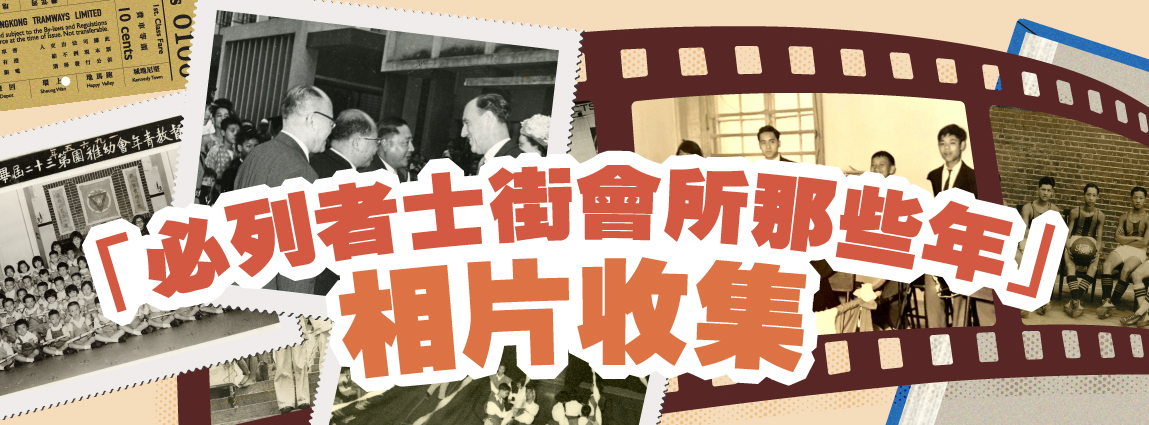
必街那些年相片收集
必列者士街會所屹立上環一百年,除了為市民提供多元化的服務及活動外,富有歷史色彩的紅磚屋外型,亦成為拍攝熱點。藉著會所成立100年的大日子,我們誠意向各位徵集在紅磚屋內外拍下的文青相、婚紗相、畢業相、家庭相及活動相;又或你珍藏的必列者士會所會員證、活動刊物等,用以設計及製作成為大型背幕,於百周年慶典當日,與大眾齊齊回味我們在必列者士街的那些年。
收相電郵:[email protected] (請註明:必街那些年)
Only Available in Chinese
短片與動畫
為慶祝本會必列者士街會所服務香港100周年,本會特別製作多條講述會所歷史的短片及動畫,當中更邀得本會會長丘頌云先生、總幹事劉俊泉先生以及國際聯青社香港地區的地區總監陳浩庭律師,分享有關必列者士街會所的背景和故事,讓大眾深入了解必列者士街會所的歷史與服務。
Only available in Chinese
(成報)
(成報)
(成報)
(The Standard)
(AM730)
(都市日報)
中國新聞網(廣東)
